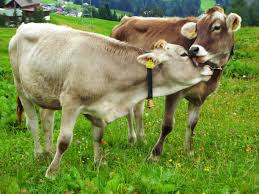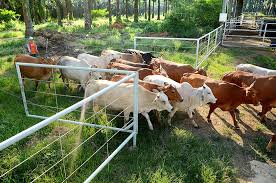There are different methods of genetic improvement in livestock breeding, for instance, the farmer has two main ways in which he can attempt to raise the performance of the animals. He can through their environment or try change their genetic make-up in other to increase their genetic potential.
The various traits or characteristics of a pig for example are genetically controlled and inherited through genes, which contain the basic hereditary material.
These genes can be manipulated to achieve genetic improvement by either increasing the frequency of favorable genes or combinations of genes by selection, or by introducing new genes into the population by crossbreeding with other breed or stains.
Selection for Genetic Improvement
Genetic traits can be divided into simple traits governed by a single pair of genes, such as shape of the ears or color, or complex traits, controlled by many genes, which include the performance traits such as growth rate, feed –conversion efficiency and carcass quality. With simple traits genes are normal dominant and recessive. If present in the heterozygote (i.e mixture of dominant and recessive genes), the dominant gene suppresses the expression of the recessive gene.
Recessive traits will thus only appear when two recessive genes come together in the homozygous form this means that occurrence of a trait in a breeding program can be predicted. As an example, if a recessive trait was desirable (e.g prick ears) then only prick –eared animals would be used as parents.
Read Also: Improvement Programs in Livestock Breeding
This pattern of inheritance was discovered by an Austrian monk called Mendel, in this class is work with green peas, and is therefore known as Mendelian inheritance. In the case of complex traits, the situation is entirely different. If we take growth rate as an example, within a given environment the individuals, who possess a greater frequency of genes favoring growth rate will exhibit superior great rates compared to the rest of the population.
Thus, if only animal with superior growth rates are selected as parents, this will increase the frequency of the favorable genes in the next generation. This may be illustrated in a population of pigs where selection is being considered according to growth rate, and only the animals growing faster than 750g/day would be used as parents. The major factors which affect the efficiency and genetic progress in selection program are as follows:
1) Definition of Genetic Objectives
It is of paramount that selection objectives are clearly defined before a breeding program is embarked upon, and that they are not subject to constant change. This is particularly important in tropical conditions, where traits as adaptability, coat color and ability to produce on low –quality diets may be more critical than growth rates or carcass characteristics.
Priorities may be completely reversed, e.g. fat gigs are preferred to thin pigs in some situations, the number of traits in a breeding program must be kept to a minimum, as the more traits are selected for simultaneously, the slower the progress for each trait.
2) Genetic Selection Differential
This is a measure of the superiority of the selected parents over the mean of the population from which they are derived; the bigger the differential, the greater the genetic progress. Clearly, the larger the variation in a heritable trait in a population, that is the scope for a bigger selection differential, the faster the rate of genetic progression.
3) Heritability

Heritability is a measure of the proportion of the superiority of the parants above their contemporaries which on average is passed to the offspring. More precisely, the heritability indicates the proportion of the total phenotypic variance that is due to additive genetic effects.
Conversely, a heritability of 100per cent indicates that the trait is totally heritable whereby differences environment between animals will not affect the phenotypic variation of such a trait. In general in the pig reproductive traits tend to be of low heritability, growth traits of medium heritability and carcass traits of relative high heritability.
Related: 50 Business Ideas for Aspiring Entrepreneurs on Agriculture
Genetic progress will always be greater when selection for traits of higher heritability (Table 1).
Table 1: Some Heritability Estimates for Important Traits in the Pig
| Heritability (%) | |
| Number piglets born per little litter Litter-size at weaning Daily weight Daily weight gain Feed-conversion efficiency Dressing-out percentage Mean backfat Carcass length | 15 7 9 21-41 20-49 26-40 43-74 40-87 |
Generation Interval
This is defined as the average age of the parents when their offspring are born, and represent the time interval between generations. The shorter the generation interval, the more rapid the genetic progress, and if young boars are mated with gilts and replaced by selected progeny after one litter, the generation turnover can be as short as one year.
Even in the normal situation where it is assumed that progeny born in first-to-fifth litters are equally likely to be chosen as replacement, pigs with an average generation interval of 2-2.5 years still have a great advantage over other domestic meat-producing species such as sheep (three-four years)and cattle (three-five years).
Accuracy of Measurement of Units
The success of a selection programmed is entirely depending, in the first instance on the accuracy of the records that are used. In this case important traits are easy to measure, e.g. live weight gain, but in others it is more difficult to be accurate, e.g. feed –conversion efficiencies and carcass measurements. Before embarking on a selection program, it is essential to ascertain that the traits involved can be accurately measured.
Estimating the Response to Selection
Once the values for heritability (h2) and selection differential (SD) and generation interval (GI) have been determined, the genetic gain per year can be estimated.
Read Also: Cross-Breeding and Artificial Insemination in Livestock Breeding


Thanks for explaining that livestock could be genetically improved. My brother is planning to have his own farm soon, so it’s great that I found this for him. I should recommend getting a livestock breeder in our area.
Thank you for the appreciation and I am glad that you find our article very useful!